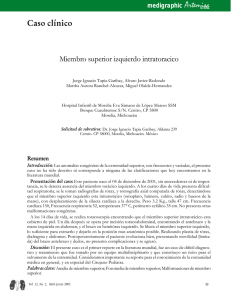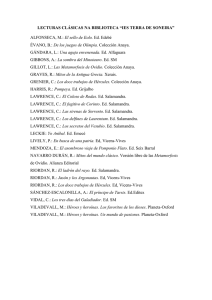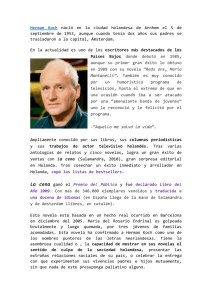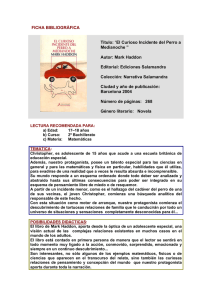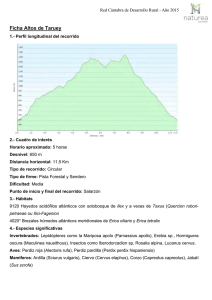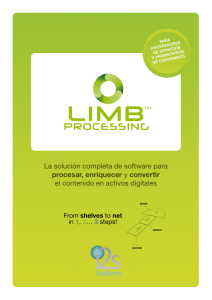Limb abnormalities in the palmate newt, Lissotriton helveticus
Anuncio
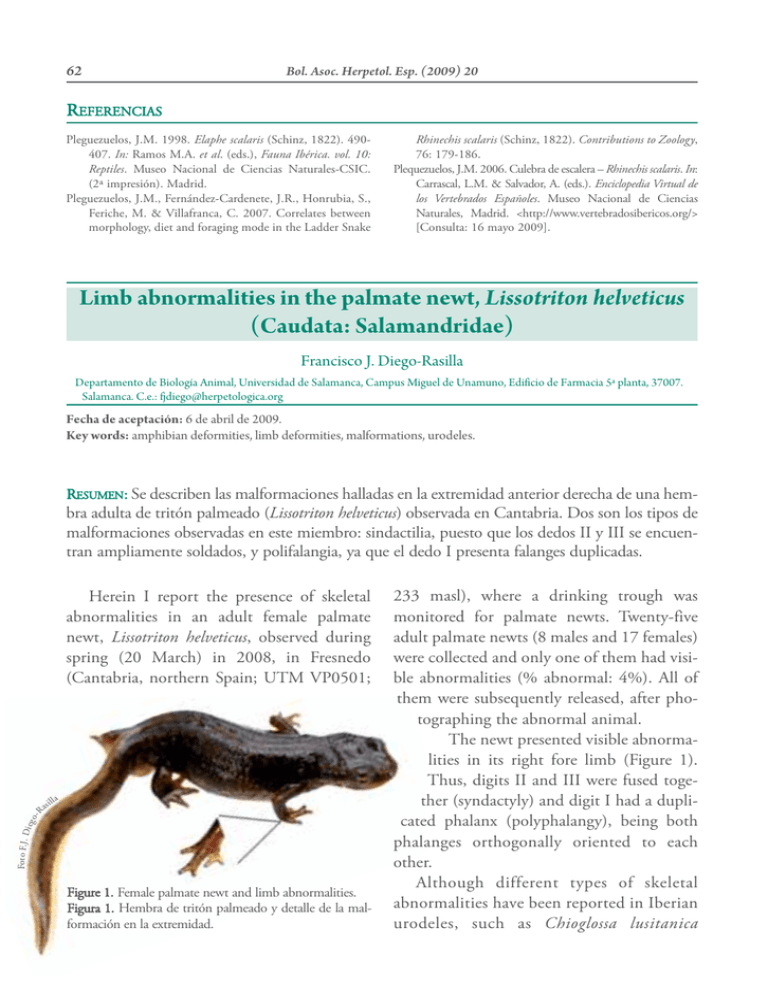
62 Bol. Asoc. Herpetol. Esp. (2009) 20 REFERENCIAS Pleguezuelos, J.M. 1998. Elaphe scalaris (Schinz, 1822). 490407. In: Ramos M.A. et al. (eds.), Fauna Ibérica. vol. 10: Reptiles. Museo Nacional de Ciencias Naturales-CSIC. (2ª impresión). Madrid. Pleguezuelos, J.M., Fernández-Cardenete, J.R., Honrubia, S., Feriche, M. & Villafranca, C. 2007. Correlates between morphology, diet and foraging mode in the Ladder Snake Rhinechis scalaris (Schinz, 1822). Contributions to Zoology, 76: 179-186. Plequezuelos, J.M. 2006. Culebra de escalera – Rhinechis scalaris. In: Carrascal, L.M. & Salvador, A. (eds.). Enciclopedia Virtual de los Vertebrados Españoles. Museo Nacional de Ciencias Naturales, Madrid. <http://www.vertebradosibericos.org/> [Consulta: 16 mayo 2009]. Limb abnormalities in the palmate newt, Lissotriton helveticus (Caudata: Salamandridae) Francisco J. Diego-Rasilla Departamento de Biología Animal, Universidad de Salamanca, Campus Miguel de Unamuno, Edificio de Farmacia 5ª planta, 37007. Salamanca. C.e.: [email protected] Fecha de aceptación: 6 de abril de 2009. Key words: amphibian deformities, limb deformities, malformations, urodeles. RESUMEN: Se describen las malformaciones halladas en la extremidad anterior derecha de una hembra adulta de tritón palmeado (Lissotriton helveticus) observada en Cantabria. Dos son los tipos de malformaciones observadas en este miembro: sindactilia, puesto que los dedos II y III se encuentran ampliamente soldados, y polifalangia, ya que el dedo I presenta falanges duplicadas. il as la Foto F.J . D ieg o -R Herein I report the presence of skeletal abnormalities in an adult female palmate newt, Lissotriton helveticus, observed during spring (20 March) in 2008, in Fresnedo (Cantabria, northern Spain; UTM VP0501; Figure 1. Female palmate newt and limb abnormalities. Figura 1. Hembra de tritón palmeado y detalle de la malformación en la extremidad. 233 masl), where a drinking trough was monitored for palmate newts. Twenty-five adult palmate newts (8 males and 17 females) were collected and only one of them had visible abnormalities (% abnormal: 4%). All of them were subsequently released, after photographing the abnormal animal. The newt presented visible abnormalities in its right fore limb (Figure 1). Thus, digits II and III were fused together (syndactyly) and digit I had a duplicated phalanx (polyphalangy), being both phalanges orthogonally oriented to each other. Although different types of skeletal abnormalities have been reported in Iberian urodeles, such as Chioglossa lusitanica Bol. Asoc. Herpetol. Esp. (2009) 20 63 (Sequeira et al., 1999), Triturus marmoratus (Diego-Rasilla, 2000; Diego-Rasilla et al., 2007) and Salamandra salamandra (Escoriza & GarcíaCardenete, 2005; Villanueva, 2007), to my knowledge, this is the first documented case of limb abnormalities in L. helveticus, and the first amphibian skeletal malformation described in Cantabria. Polyphalangy (extra bones in a digit), together with ectrodactyly (missing toe) and brachydactyly (dwarfed toe) are among the more frequent skeletal malformations found in urodeles (Diego-Rasilla et al., 2007; Williams et al., 2008) . On the contrary, syndactyly (fused digits), as well as polymelia (excessive number of limbs) and phocomelia (absence of proximal portion of limb) are rare in urodeles (Escoriza & García- rates should not be treated as significant because of the small number of newts found in this place, and a high occurrence of limb abnormalities can not been concluded from the available data. Multiple etiologies could be responsible from these malformations; however, the available information does not permit to determine causes for the observed malformations. They could be attributed to both anthropogenic and natural changes in the abiotic and biotic factors in the environment. Suggested causes for these abnormalities include parasites and pathogens, UV radiation, regeneration following trauma, high levels of anthropogenic pollution, or synergistic interactions of some or all of these factors (Blaustein et al., 1997; Reaser & Cardenete, 2005; Diego-Rasilla et al., 2007; Johnson, 1997; Gillilland & Muzzall, 2002; Villanueva, 2007; Williams et al., 2008). Johnson et al., 2002; Diego-Rasilla et al., 2007; Observed rates of visual abnormalities (4%) exceeded the baseline abnormality percentage of 0-2% predicted in amphibian populations (Ouellet, 2000); however, these Williams et al., 2008). ACKNOWLEDGEMENTS: Animals were collected under permits issued by the Cantabria autonomous government. REFERENCES Blaustein, A. R., Kiesecker, J. M., Chivers, D. P. & Anthony, R. G. 1997. Ambient UV-B radiation causes deformities in amphibian embryos. Proceedings of the National Academy of Sciences of the USA, 94: 13735–13737. Diego-Rasilla, F. J. 2000. Malformaciones en una población de Triturus marmoratus. Boletín de la Asociación Herpetológica Española, 11: 88-89. Diego-Rasilla, F. J., Luengo, R. M. & Rodríguez-García, L. 2007. Triturus marmoratus (Marbled Newt). Limb abnormalities. Herpetological Review, 38: 68. Escoriza, E. & García-Cardenete, L. 2005. Polimelia en Alytes dickhilleni y Salamandra salamandra longirostris. Dos casos de ejemplares con seis extremidades. Boletín de la Asociación Herpetológica Española, 16: 39-41 Gillilland, M. G., & Muzzall, P. M. 2002. Amphibians, trematodes, and deformities: An overview from Southern Michigan. Comparative Parasitology, 69, 81-85. Johnson, P. T., Lunde, K. B., Thurman, M., Ritchie, E. G., Wray, S. N., Sutherland, D. R., Kapfer, J. M., Frest, T. J., Bowerman, J. & Blaustein, A. R. 2002. Parasite (Ribeiroia ondatrae) infection linked to amphibian malformations in the Western United States. Ecological Monographs, 72: 151–168. Ouellet M. 2000. Amphibian Deformities: Current State of Knowledge. 617-646. In: Sparling, D. W., Linder, G. & Bishop, C. A. (eds.), Ecotoxicology of Amphibians and Reptiles. Society of Environmental Toxicology and Chemistry (SETAC). Pensacola, FL. Sequeira, F., Gonçalves, H., Meneses, C. & Mouta-Faria, M. 1999. Morphological abnormalities in a population of Chioglossa lusitanica. Boletín de la Asociación Herpetológica Española, 10: 35-36. Reaser, J. K. & Johnson, P.T. 1997. Amphibians abnormalities: a review. Froglog, 24: 2-3. Villanueva, A. 2007. Polimelia en un ejemplar de Salamandra salamandra en Asturias. Boletín de la Asociación Herpetológica Española, 18: 90-91. Williams, R. N., Bos, D. H., Gopurenko, D. & DeWoody, J. A. 2008. Amphibian malformations and inbreeding. Biology Letters, 4: 549-552.
